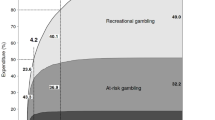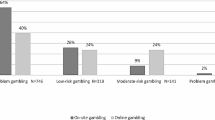Abstract
Objectives
The purpose of this study is to provide an updated profile of gamblers and problem gamblers in Canada and to identify characteristics most strongly associated with problem gambling.
Methods
An assessment of gambling participation and problem gambling was included in the 2018 Canadian Community Health Survey and administered to 23,952 individuals 18 years and older. Descriptive statistics provided a demographic profile for each type of gambling involvement as well as category of gambler (non-gambler, non-problem gambler, at-risk gambler, problem gambler). A logistic regression identified characteristics that best distinguished problem from non-problem gamblers.
Results
Gambling participation and problem gambling both varied as a function of gender, income, educational attainment, and race/ethnicity. However, multivariate analysis identified electronic gambling machine (EGM) participation to be the primary predictor of problem gambling status, with race/ethnicity, presence of a mood disorder, male gender, casino table game participation, older age, a greater level of smoking, participation in speculative financial activity, instant lottery participation, lower household income, and lottery or raffle ticket participation providing additional predictive power. Provincial EGM density and EGM participation rates are also very strong predictors of provincial rates of at-risk and problem gambling.
Conclusion
Problem gambling has a biopsychosocial etiology, determined by personal vulnerability factors combined with the presence of riskier types of gambling such as EGMs. Effective prevention requires a multifaceted approach, but constraints on the availability and operation of EGMs would likely have the greatest single public health benefit.
Résumé
Objectifs
Présenter un profil actualisé des joueurs et des joueurs pathologiques au Canada et cerner les caractéristiques les plus fortement associées au jeu pathologique.
Méthode
Une évaluation de la participation au jeu de hasard et du jeu pathologique figurant dans l’Enquête sur la santé dans les collectivités canadiennes de 2018 a été administrée à 23 952 personnes de 18 ans et plus. Le profil démographique de chaque type de participation au jeu de hasard et la catégorie de joueur (non-joueur, joueur non pathologique, joueur à risque, joueur pathologique) ont été établis par statistique descriptive. Une régression logistique a permis de cerner les caractéristiques qui distinguaient le mieux les joueurs pathologiques des joueurs non pathologiques.
Résultats
La participation au jeu de hasard et le jeu pathologique variaient tous les deux en fonction du sexe, du revenu, du niveau d’instruction et de la race/l’ethnicité. L’analyse multivariée a cependant déterminé que l’utilisation d’appareils électroniques de jeu (AÉJ) était la principale variable prédictive du jeu pathologique, et que la race/l’ethnicité, la présence d’un trouble de l’humeur, le sexe masculin, la participation aux jeux de table dans les casinos, l’âge avancé, le tabagisme important, la participation à des activités financières spéculatives, la participation aux loteries instantanées, le faible revenu du ménage et l’achat de billets de loterie ou de tirage au sort amélioraient le pouvoir de prédiction. La densité provinciale des AÉJ et les taux d’utilisation des AÉJ étaient aussi de très fortes variables prédictives des taux provinciaux de jeu à risque et de jeu pathologique.
Conclusion
Le jeu pathologique présente une étiologie biopsychosociale déterminée par des facteurs de vulnérabilité personnels combinés à la présence de types de jeu de hasard plus risqués, comme les AÉJ. Une prévention efficace nécessite une démarche pluridimensionnelle, mais l’imposition de limites à la disponibilité et à l’utilisation des AÉJ serait probablement la solution la plus avantageuse sur le plan de la santé publique.
Similar content being viewed by others
References
Afifi, T. O., Cox, B. J., Martens, P. J., Sareen, J., & Enns, M. W. (2010). Demographic and social variables associated with problem gambling among men and women in Canada. Psychiatry Research, 178(2), 395–400. https://doi.org/10.1016/j.psychres.2009.10.003.
Binde, P., Romild, U., & Volberg, R. A. (2017). Forms of gambling, gambling involvement and problem gambling: Evidence from a Swedish population survey. International Gambling Studies, 17(3), 490–507. https://doi.org/10.1080/14459795.2017.1360928.
Cox, B. J., Yu, N., Afifi, T. O., & Ladouceur, R. (2005). A national survey of gambling problems in Canada. Canadian Journal of Psychiatry, 50(4), 213–217. https://doi.org/10.1177/070674370505000404.
Delfabbro, P., & King, D. L. (2019). Challenges in the conceptualisation and measurement of gambling-related harm. Journal of Gambling Studies, 35, 743–755. https://doi.org/10.1007/s10899-019-09844-1.
el-Guebaly, N., Casey, D. M., Currie, S., Hodgins, D. C., Schopflocher, D., Smith, G. J., et al. (2015). The Leisure, Lifestyle, & Lifecycle Project (LLLP): A longitudinal study of gambling in Alberta. Final report for the Alberta Gambling Research Institute. February 2015. https://doi.org/10.11575/PRISM/9908. Accessed 17 May 2020.
Ferris, J., & Wynne, H. (2001). The Canadian Problem Gambling Index: Final report. Ottawa: Submitted to the Canadian Centre on Substance Abuse.
Griffiths, S., Reith, G., Wardle, H., & Mackie, P. (2020). Pandemics and epidemics: public health and gambling harms. Public Health, 184, 1–2. https://doi.org/10.1016/j.puhe.2020.06.022.
Hing, N., Russell, A., Tolchard, B., & Nower, L. (2016). Risk factors for gambling problems: An analysis by gender. Journal of Gambling Studies, 32(2), 511–534. https://doi.org/10.1007/s10899-015-9548-8.
Ladouceur, R., Jacques, C., Chevalier, S., Sévigny, S., & Hamel, D. (2005). Prevalence of pathological gambling in Quebec in 2002. Canadian Journal of Psychiatry, 50(8), 451–456. https://doi.org/10.1177/070674370505000804.
Langham, E., Thorne, H., Browne, M., Donaldson, P., Rose, J., & Rockloff, M. (2015). Understanding gambling related harm: A proposed definition, conceptual framework, and taxonomy of harms. BMC Public Health, 16(1), 80.
MacLaren, V. V. (2016). Video lottery is the most harmful form of gambling in Canada. Journal of Gambling Studies, 32(2), 459–485. https://doi.org/10.1007/s10899-015-9560-z.
Statistics Canada. (2002). Canadian Community Health Survey Cycle 1.2 Mental Health and Well-Being. https://www23.statcan.gc.ca/imdb/p2SV.pl?Function=getSurvey&Id=5285. Accessed 17 May 2020
Statistics Canada. (2019a). Canadian Community Health Survey (CCHS) annual component and user guide. Ottawa: Statistics Canada.
Statistics Canada. (2019b). Canadian Community Health Survey (CCHS) rapid response on gambling. Complement to the user guide. Ottawa: Statistics Canada.
Stone, C. A., Romild, U., Abbott, M., Yeung, K., Billi, R., & Volberg, R. (2015). Effects of different screening and scoring thresholds on PGSI gambling risk segments. International Journal of Mental Health and Addiction, 13(1), 82–102. https://doi.org/10.1007/s11469-014-9515-0.
Storer, J., Abbott, M., & Stubbs, J. (2009). Access or adaptation? A meta-analysis of surveys of problem gambling prevalence in Australia and New Zealand with respect to concentration of electronic gaming machines. International Gambling Studies, 9(3), 225–244. https://doi.org/10.1080/14459790903257981.
Welte, J. W., Barnes, G. M., Tidwell, M.-C. O., & Wieczorek, W. F. (2017). Predictors of problem gambling in the U.S. Journal of Gambling Studies, 33(2), 327–342. https://doi.org/10.1007/s10899-016-9639-1.
Williams, R. J., & Volberg, R. A. (2009). Impact of survey description, administration format, and exclusionary criteria on population prevalence rates of problem gambling. International Gambling Studies, 9(2), 101–117. https://doi.org/10.1080/14459790902911653.
Williams, R. J., & Volberg, R. A. (2012). Population assessment of problem gambling: Utility and best practices. Report for the Ontario Ministry of Health and Long-Term Care and the Ontario Problem Gambling Research Centre. https://hdl.handle.net/10133/3094. Accessed 17 May 2020.
Williams, R. J., & Volberg, R. A. (2014). The classification accuracy of four problem gambling assessment instruments in population research. International Gambling Studies, 14(1), 15–28. https://doi.org/10.1080/14459795.2013.839731.
Williams, R. J., Volberg, R. A., & Stevens, R. M. G. (2012a). Population prevalence of problem gambling: Methodological influences, standardized rates, jurisdictional differences, and worldwide trends. Report prepared for the Ontario Ministry of Health and Long-Term Care and the Ontario Problem Gambling Research Centre. https://hdl.handle.net/10133/3068. Accessed 17 May 2020.
Williams, R. J., West, B. L., & Simpson, R. I. (2012b). Prevention of problem gambling: A comprehensive review of the evidence, and identified best practices. Report prepared for the Ontario Problem Gambling Research Centre and the Ontario Ministry of Health and Long Term Care. https://hdl.handle.net/10133/3121. Accessed 17 May 2020.
Williams, R. J., Hann, R., Schopflocher, D., West, B., McLaughlin, P., White, N., et al. (2015). Quinte longitudinal study of gambling and problem gambling. Report prepared for the Ontario Problem Gambling Research Centre. https://hdl.handle.net/10133/3641. Accessed 17 May 2020.
Williams, R. J., Leonard, C. A., Belanger, Y. D., Christensen, D. R., el-Guebaly, N., Hodgins, D. C., McGrath, D. S., Nicholl, F., Stevens, R. M. G. (in press). Gambling and problem gambling in Canada: prevalence and changes since 2002. Canadian Journal of Psychiatry (in press).
Williams, R. J., Volberg, R. A., Stevens, R. M. G., Williams, L. A., & Arthur, J. N. (2017). The definition, dimensionalization, and assessment of gambling participation. Report for the Canadian Consortium for Gambling Research. https://hdl.handle.net/10133/4838. Accessed 17 May 2020.
Acknowledgements
We thank the Canadian Consortium for Gambling Research (CCGR) for funding the development and inclusion of the Gambling Module in the CCHS. Special thanks also go to Dr. Seamus O’Shea, Alberta Gambling Research Institute (AGRI) Board Chair, and Glenda Wong, AGRI Executive Director, for their foresight in helping to formulate and develop the AGRI National Project (ANP) and in facilitating its successful implementation. The present study is part of the ANP, which is a comprehensive national study of gambling jointly funded by the CCGR, the Canadian Centre on Substance Use and Addiction, Gambling Research Exchange Ontario (GREO), and AGRI. Details can be obtained on our website: https://www.ucalgary.ca/research/national-gambling-study/. As mentioned, the Gambling Module was specifically funded by CCGR. GREO exclusively contributed to the funding of the Project Manager to clean ANP data for eventual housing with GREO to facilitate public access for other researchers.
Author information
Authors and Affiliations
Corresponding author
Ethics declarations
Conflict of interest
The authors declare that they have no conflict of interest.
Additional information
Publisher’s note
Springer Nature remains neutral with regard to jurisdictional claims in published maps and institutional affiliations.
Rights and permissions
About this article
Cite this article
Williams, R.J., Leonard, C.A., Belanger, Y.D. et al. Predictors of gambling and problem gambling in Canada. Can J Public Health 112, 521–529 (2021). https://doi.org/10.17269/s41997-020-00443-x
Received:
Accepted:
Published:
Issue Date:
DOI: https://doi.org/10.17269/s41997-020-00443-x




